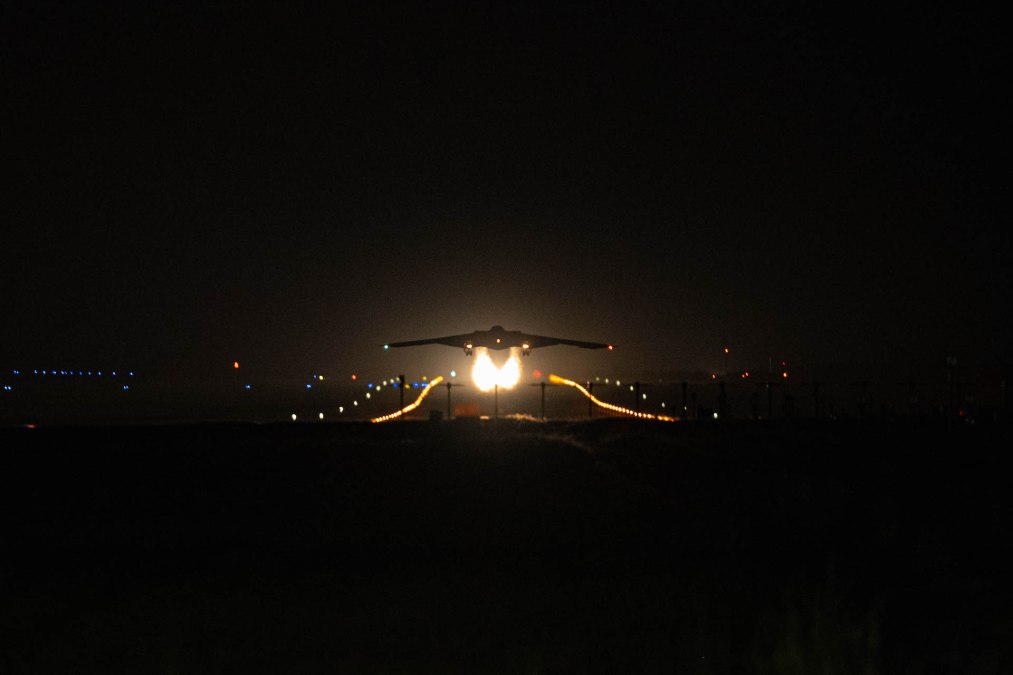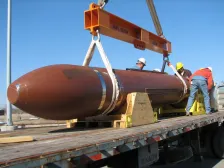Joint Chiefs chairman supplies new details about MOP bomb attack on Iranian nuclear sites

Air Force B-2 bombers dropped a total of 12 “massive ordnance penetrator” bombs — each one with a uniquely programmed fuze — on two different ventilation shafts at Iran’s nuclear facility at Fordow last weekend during Operation Midnight Hammer, Chairman of the Joint Chiefs of Staff Gen. Dan Caine told reporters Thursday.
The 30,000-pound GBU-57 bombs, also known as MOPs, used in this assault were designed to attack deep underground targets in locations that are hundreds of feet below ground level.
Caine and Defense Secretary Pete Hegseth briefed reporters at the Pentagon Thursday regarding the military’s planning and execution of the U.S. airstrikes on Iranian nuclear facilities, which marked the first-ever operational employment of the MOP weapon.
Early testing of the MOP began roughly two decades ago under a technology demonstration effort led by the Defense Threat Reduction Agency before being transitioned to the Air Force. Super computers were used for modeling and simulation during the development of the weapon, Caine noted during Thursday’s briefing. The chairman said he met yesterday with two DTRA officers who “spent their life’s work” enabling and demonstrating the complex bombs.
The U.S. used these so-called bunker-buster bombs on two nuclear facilities — in Fordow and Natanz — last weekend. Caine noted that the U.S. targeted ventilation shafts at Iran’s nuclear facility in Fordow.
The MOP is “comprised of steel, explosive and a fuze programmed bespokely [for] each weapon to achieve a particular effect inside the target. Each weapon had a unique desired impact, angle, arrival, final heading and a fuze setting. The fuze is effectively what tells the bomb when to function. A longer delay in a fuze, the deeper the weapon will penetrate and drive into the target,” he explained.

The U.S. military decided to strike two of the ventilation shafts at Fordow as the primary points of entry into the underground facility. In the days preceding the attack, the Iranians attempted to cover the shafts with concrete to try to thwart an attack, according to Caine.
“I won’t share the specific dimensions of the concrete cap. But you should know that we know what the dimensions of those concrete caps were. The planners had to account for this. They accounted for everything. The cap was forcibly removed by the first weapon and the main shaft was uncovered. Weapons two, three, four [and] five were tasked to enter the main shaft, move down into the complex at greater than 1000 feet per second and explode in the mission space,” he said. “There were six on each side. Weapons number six was designed as a flex weapon to allow us to cover if one of the preceding jets or one of the preceding weapons did not work.”
Two additional MOPs were used on Natanz. A total of 14 were dropped during Midnight Hammer.
During a previous briefing on Sunday, Caine said that early battle damage assessments suggested that the “massive ordnance penetrator” bombs dropped by U.S. Air Force B-2 Spirit stealth bombers severely damaged Iran’s nuclear arsenal.
On Thursday, he said all of the MOPs used against Fordow went exactly where they were intended to go.
“A bomb has three effects that causes damage: blast, fragmentation and overpressure. In this case, the primary kill mechanism in the mission space was a mix of overpressure and blast ripping through the open tunnels and destroying critical hardware. The majority of the damage we assess, based on our extensive modeling, was a blast layer combined with the impulse extending from the shock,” he told reporters.
Hegseth criticized recent reporting about an intelligence assessment from the Defense Intelligence Agency in the wake of the attacks that suggested the airstrikes might not have damaged Iran’s nuclear program as much as senior Trump administration officials have claimed. Hegseth told reporters that there was “low confidence in this particular report.”
Caine said the intelligence community is in charge of the battle damage assessments.
“But here’s what we know following the attacks and the strikes on Fordow. First, that the weapons were built, tested and loaded properly. Two, the weapons were released on speed and on parameters. Three, the weapons all guided to their intended targets and to their intended aim points. Four, the weapons function as designed, meaning they exploded. We know this through other means, intelligence means that we have,” Caine said. “We were visibly able to see them. And we know that the trailing jets saw the first weapons function, and the pilot stated, quote, ‘this was the brightest explosion that I’ve ever seen. It literally looked like daylight’” even though the attacks occurred in darkness.






